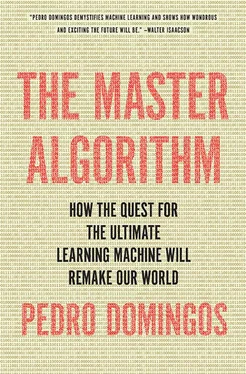The dense ranks of instances end abruptly, and you find yourself in the inverse deduction district, a place of broad avenues and ancient stone buildings. The architecture here is geometric, austere, made of straight lines and right angles. Even the severely pruned trees have rectangular trunks, and their leaves are meticulously labeled with class predictions. The denizens of this district seem to build their houses in a peculiar way: they start with the roof, which they label “Conclusions,” and gradually fill in the gaps between it and the ground, which they label “Premises.” One by one, they find a stone block that’s the right shape to fill in a particular gap and hoist it up to its place. But, you notice, many gaps have the same shape, and it would be faster to cut and combine blocks until they form that shape, and then repeat the process as many times as necessary. In other words, you could use genetic search to do inverse deduction. Neat. It looks like you’ve boiled down the five optimizers to a simple recipe: genetic search for structure and gradient descent for parameters. And even that may be overkill. For a lot of problems, you can whittle genetic search down to hill climbing if you do three things: leave out crossover, try all possible point mutations in each generation, and always select the single best hypothesis to seed the next generation.
What’s that statue up ahead? Aristotle, looking rather disapprovingly toward the tangled mess of the gradient descent quarter. You’ve come full circle. You have the unified optimizer you need for the Master Algorithm, but this is no time to congratulate yourself. Night has fallen, and you still have much to do. You enter the Citadel of Evaluation through the imposing but rather narrow Accuracy Gate. The inscription above it says “Abandon all hope of overfitting, ye who enter here.” As you circle past the palaces of the five tribes’ evaluators, you mentally snap the pieces into place. You use accuracy to evaluate yes-or-no predictions and squared error for continuous ones. Fitness is just the evolutionaries’ name for the scoring function; you can make it anything you want, including accuracy and squared error. Posterior probability reduces to squared error if you ignore the prior probability and the errors follow a normal distribution. The margin, if you allow it to be violated for a price, becomes a softer version of accuracy: instead of paying no penalty for a correct prediction and a penalty of one for an incorrect prediction, the penalty is zero until you get inside the margin, at which point it starts to steadily go up. Whew! Combining the evaluators was a lot easier than combining the optimizers. But the Towers of Representation, looming above you, fill you with a sense of foreboding.
You’ve reached the final stage of your quest. You knock on the door of the Tower of Support Vectors. A menacing-looking guard opens it, and you suddenly realize that you don’t know the password. “Kernel,” you blurt out, trying to keep the panic from your voice. The guard bows and steps aside. Regaining your composure, you step in, mentally kicking yourself for your carelessness. The entire ground floor of the tower is taken up by a lavishly appointed circular chamber, with what seems to be a marble representation of an SVM occupying pride of place at the center. As you walk around it, you notice a door on the far side. It must lead to the central tower-the Tower of the Master Algorithm. The door seems unguarded. You decide to take a shortcut. Slipping through the doorway, you walk down a short corridor and find yourself in an even larger pentagonal chamber, with a door in each wall. In the center, a spiral staircase rises as high as the eye can see. You hear voices above and duck into the doorway opposite. This one leads to the Tower of Neural Networks. Once again you’re in a circular chamber, this one with a sculpture of a multilayer perceptron as the centerpiece. Its parts are different from the SVM’s, but their arrangement is remarkably similar. Suddenly you see it: an SVM is just a multilayer perceptron with a hidden layer composed of kernels instead of S curves and an output that’s a linear combination instead of another S curve.
Could it be that the other representations also have a similar form? With rising excitement, you run back through the pentagonal chamber and into the Tower of Logic. Staring at the depiction of a set of rules in the center, you try to discern a pattern. Yes! Each rule is just a highly stylized neuron. For example, the rule If it’s a giant reptile and breathes fire then it’s a dragon is just a perceptron with weights of one for it’s a giant reptile and breathes fire and a threshold of 1.5. And a set of rules is a multilayer perceptron with a hidden layer containing one neuron for each rule and an output neuron to form the disjunction of the rules. There’s a nagging doubt in the back of your mind, but you don’t have time for it right now. As you cross the pentagonal chamber to the Tower of Genetic Programs, you can already see how to bring them into the fold. Genetic programs are just programs, and programs are just logic constructs. The sculpture of a genetic program in the chamber is in the shape of a tree, subroutines branching into more subroutines, and when you look closely at the leaves, you can see that they’re just simple rules. So programs boil down to rules, and if rules can be reduced to neurons, so can programs.
On to the Tower of Graphical Models. Unfortunately, the sculpture in its circular chamber looks nothing like the others. A graphical model is a product of factors: conditional probabilities, in the case of Bayesian networks, and non-negative functions of the state, in the case of Markov networks. Try as you might, you just can’t see the connection to neural networks or sets of rules. Disappointment washes over you. But then you put on your “loggles,” which replace every function by its logarithm. Eureka-the product of factors is now a sum of terms, just like an SVM, a voting set of rules, or a multilayer perceptron without the output S curve. For example, you can translate a Naïve Bayes dragon classifier into a perceptron whose weight for breathes fire is the log of P(breathes fire | dragon) minus the log of P(breathes fire | not dragon) . But of course, graphical models are much more general than this because they can represent probability distributions over many variables, not just the distribution of one variable (the class) given the others (the attributes).
You did it! Or did you? Absorbing SVMs into neural networks and neural networks into graphical models: that worked. So did absorbing genetic programs into logic. But combining logic and graphical models? Something is amiss there. Belatedly, you see the problem: logic has a dimension that graphical models lack and vice versa. The sculptures in the five chambers matched because they were simple allegories, but the reality doesn’t. Graphical models don’t let us represent rules involving more than one object, like Friends of friends are friends ; all their variables have to be properties of the same object. They also can’t represent arbitrary programs, which pass sets of variables from one subroutine to another. Logic can easily do both of these things, but on the other hand it can’t represent uncertainty, ambiguity, or degrees of similarity. And without a representation that can do all of these things, you don’t have a universal learner.
You rack your brains for a solution, but the more you try, the harder it gets. Perhaps unifying logic and probability is just beyond human ability. Exhausted, you fall asleep. A deep growl jolts you awake. The hydra-headed complexity monster pounces on you, jaws snapping, but you duck at the last moment. Slashing desperately at the monster with the sword of learning, the only one that can slay it, you finally succeed in cutting off all its heads. Before it can grow new ones, you run up the stairs.
Читать дальше












